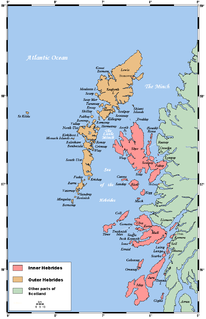
The Orkneyinga saga is a historical narrative of the history of the Orkney and Shetland islands and their relationship with other local polities, particularly Norway and Scotland. The saga has "no parallel in the social and literary record of Scotland" and is "the only medieval chronicle to have Orkney as the central place of action". The main focus of the work is the line of jarls who ruled the Earldom of Orkney, which constituted the Norðreyjar or Northern Isles of both Orkney and Shetland and there are frequent references to both archipelagoes throughout.

Saint Magnus Erlendsson, Earl of Orkney, sometimes known as Magnus the Martyr, was Earl of Orkney from 1106 to about 1115.
Rognvald Eysteinsson was the founding Jarl of Møre in Norway, and a close relative and ally of Harald Fairhair, the earliest known King of Norway. In the Norse language he is known as Rognvaldr Eysteinsson and in modern Norwegian as Ragnvald Mørejarl. He is sometimes referred to with bynames that may be translated into modern English as "Rognvald the Wise" or "Rognvald the Powerful".

The Earl of Orkney was originally a Norse jarl ruling the Norðreyjar. Originally founded by Norse invaders, the status of the rulers of the Norðreyjar as Norwegian vassals was formalised in 1195. Although the Old Norse term jarl looks similar to "earl", and the jarls were succeeded by earls in the late 15th century, a Norwegian jarl is not the same thing. In the Norse context the distinction between jarls and kings did not become significant until the late 11th century and the early jarls would therefore have had considerable independence of action until that time. The position of Jarl of Orkney was eventually the most senior rank in mediaeval Norway except for the king himself.
Einarr Rognvaldarson often referred to by his byname Torf-Einarr, was one of the Norse Earls of Orkney. The son of the Norse jarl, Rognvald Eysteinsson and a concubine, his rise to power is related in sagas which apparently draw on verses of Einarr's own composition for inspiration. After battling for control of the Northern Isles of Scotland and a struggle with Norwegian royalty, Einarr founded a dynasty which retained control of the islands for centuries after his death.
Sigurd Hlodvirsson, popularly known as Sigurd the Stout from the Old Norse Sigurðr digri, was an Earl of Orkney. The main sources for his life are the Norse Sagas, which were first written down some two centuries or more after his death. These engaging stories must therefore be treated with caution rather than as reliable historical documents.

Rognvald Kale Kolsson was an Earl of Orkney and a Norwegian saint.
Rognvald Brusason , son of Brusi Sigurdsson, was Earl of Orkney jointly with Thorfinn Sigurdsson from about 1037 onwards. His life is recorded in the Orkneyinga Saga.
Paul Thorfinnsson and Erlend Thorfinnsson were brothers who ruled together as Earls of Orkney. Paul and Erlend were the sons of Thorfinn Sigurdsson and Ingibiorg Finnsdottir. Through Ingibiorg's father Finn Arnesson and his wife, the family was related to the Norwegian Kings Olav II and Harald II. They are both described as "tall, handsome men, shrewd and gentle, taking rather more after their mother's side of the family. Their lives and times are recounted in the Orkneyinga Saga, which was first written down in the early 13th century by an unknown Icelandic author.
Haakon Paulsson was a Norwegian Jarl (1105–1123) and jointly ruled the Earldom of Orkney with his cousin Magnus Erlendsson. Their lives and times are recounted in the Orkneyinga Saga, which was first written down in the early 13th century by an unknown Icelandic author.
Harald Eiríksson , also known as Harald the Young, was joint Earl of Orkney with Harald Maddadsson. He was the son of Orkney chief Eirik Stagbrell and Ingerid Ragnvaldsdotter, the daughter of Rögnvald Kali Kolsson, the former Earl of Orkney.
Orcadians are the people who live in or come from the Orkney islands of Scotland. Historically, they are descended from the Picts, Norse and Scots.
Hildr or RagnhildrHrólfsdóttir was a 9th-century woman who is referenced in various Old Norse sources including Óláfs saga, Orkneyinga saga and Landnámabók.

Damsay is an islet in the Orkney archipelago in Scotland. It is approximately 18 hectares (0.07 sq mi) in extent and rises to only 11 metres (36 ft) above sea level. It is situated in the Bay of Firth north of the Orkney Mainland near Finstown. Nearby is the smaller islet of Holm of Grimbister.
Helga Moddansdóttir was the mistress of Haakon Paulsson who was Earl of Orkney from 1105–1123.












